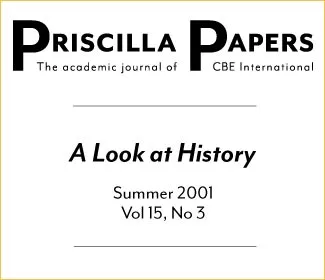There is considerable evidence of women deacons, elders, and even bishops in the early life of the church
History—at least official history—is always written by the winners. For some time, the advocates of an institutional, hierarchical, orderly, and preeminently masculine vision of the church have undoubtedly been the winners, and they have been permitted to frame the discussion.
John Driver has outlined what he considers to be a biblical vision of church history based on the motif of the righteous remnant,1 a vision characterized by weakness and insignificance (Deut 2:24-25; 6:2-8). Christ and his church, who suffered persecution by established political and religious interests and refused to dominate others in return, represent the continuation of this ideal.
Yet, within several centuries, the power of the Roman empire ‘would become wedded to the Christian religion, and many church historians would turn this biblical vision upside down. Thus Eusebius, and most church historians after him, ignored the biblical motif in favor of a Greco-Roman, dynastic approach. So Driver concludes: “Due to the Constantinian changes, the history of the Christian church became what Professor Dussel termed an ‘anti-Christian inversion.’ The church’s memory was twisted to serve the purposes of established powers and their institutions, rather than the needs of the Christian people.”2
The views of the established hierarchy have therefore been preserved and those of their opponents ignored, if not actively suppressed.
But it is not enough to assert what the “canonical” authorities have decreed—as if this closed the debate. There is early evidence for a “feminized” vision of Christianity. Celsus‚ in his True Discourse (c. 175), complains that Christianity was a religion of women and menials. Christian teachers, he claims, “lead children astray and tell them that, if they wish (to avail themselves of their aid), they must leave their fathers and their instructors, and go with the women and their playfellows to the women’s apartments, or to the leather shop, or to the fuller’s shop, that they may gain perfection” (Origen, Against Celsus, 3:55).
Celsus does not say that women are leaders in the church, but he does acknowledge their prominence within the movement.
Early Beliefs
Montanists. In the second century— at least in some churches—women were allowed to prophesy.3 This was true of the Montanists, who also specifically allowed female clergy. Even their enemies admitted that Montanist theology was orthodox. Montanists stressed rigorous asceticism and freedom in the Spirit from institutional restrictions. But beyond this, as church historians attest, Montanists were quite orthodox, and charges that they were doctrinal heretics are unfounded.4
Schepelern’s analysis of Montanism concludes that the movement’s spiritual ties were not to pagan cults but to the Jewish-Christian apocalyptic tradition.5 The prophetic impulse has an honored pedigree in the early church. The Didache (c. 100) regulates the ministry of itinerant prophets. Justin Martyr (c. 150) noted the ongoing presence of charismatic prophets in Rome. The New Prophecy, as Montanists called their movement, was a movement of dissent, not heresy, a reaction against the increasing institutionalization of ecclesiastical authority. Rather than blindly following bishops and dogmas, Montanists focused on “continuing apostolic practice.”6 They were a charismatic protest movement that “advocated the formation of communities in which Christians could hear the living voice of the Holy Spirit.”7
Montanists, for all their excesses, have as much claim to a first-century pedigree as their opponents. As an apocalyptically minded Jewish-Christian community, they had much to commend them. They met resistance from ecclesiastical authorities precisely because they were seeking to conserve what the institutional church seemed intent upon throwing away. The New Prophecy “sounded much like the earliest Christian expectations and enthusiasms”:8 prophetic revelations, moral rigorism, martyrdom, women prophesying, and spontaneous charismatic outbursts.
“Montanistic” figures. Despite systematic oppression by the institutional church, Montanism persisted into the sixth century. The prophetic strain continued in rural areas, even as its influence waned in the cities.9 This was true in catholic communities as well:
The evidence for the continuation of the charism of prophecy in catholic churches is scattered but real in the second and third centuries, and so far as Phrygia and surrounding provinces were concerned, I would posit that the New Prophecy would not have taken such firm hold in them, and have spread so quickly, had prophecy not been a reality in some congregations there, though diminished or lost in others.10
Historical ambiguity. “Montanistic” figures are those whose religious affiliation is unclear, a category that might include, among others, the Lyons martyrs of 177—who rejected individualistic actions that were destructive of unity but were “otherwise not unfavorable to the New Prophecy”11—and Perpetua and Felicitas.12
The fact of ambiguity is relevant. None of these figures are patently Montanists, and all can be understood as catholic. Trevett notes, “The fact is that Christian groups, catholic and other and even heretical, were in close association with one another. . . . The carefully delineated demarcations of the Fathers’ devising serve to remind us how much such lines of demarcation were disregarded in practice.”13
Thecla. The Acts of Paul and Thecla is part of the larger Acts of Paul, written c. 190. Thecla is hailed as a missionary associate of Paul, who baptized herself (4:34) and was commissioned by Paul to “go and teach the word of God” (4:41). Some Christians appealed to Thecla in support of women leaders in the church, including the right to baptize and teach.
Tertullian opposed this practice and condemned the Acts of Paul (On Baptism, 17), noting that its author was removed from his post as presbyter. Not everyone agreed. Hippolytus “evidently uses the work without question.”14 Although Eusebius did not regard the book as canonical, neither did he condemn it as heretical (Ecclesiastical History 3:25). Rodorf concludes that a Montanist wrote it. Schneemelcher disagrees, arguing it is not possible to demonstrate “specifically Montanist ideas.”15 Rather, he sees features that are more generally a part of the church of the second century, including emphasis on the Holy Spirit, asceticism, and downplaying the role of church officers.16
Other dissenters. Montanists and their kin were not the only early dissenters. Evidence for others, perhaps isolated pockets of resistance, follow.
Women As Deacons
Pliny the Younger, writing to Emperor Trajan around 112, speaks of detaining two ministrae (Epistle 96).17Minister (fem. ministra) would be the most logical Latin translation of the Greek diakonos. The term deaconess may have referred to a clerical office at this time, but scholars are uncertain.18 It is known that a century later there was a clerical office of “deaconess.” There are twenty-eight known tombstones commemorating deaconesses.
Origin. The first specific reference to the order of deaconesses is in the Didascalia (c. 250). Deaconesses flourished in Syria and Greece from the third to perhaps the eighth century. Theodore of Mopsuestia (d. 426) understood deaconesses to be an order of apostolic origin.19
Duties. Four basic duties were assigned to deaconesses.
1. Pastoral care. Deaconesses were to care for the sick and needy, especially the widows (Apostolic Constitutions 3:7, 14). “Let the deaconess be diligent in taking care of the women; but both of them [male and female] ready to carry messages, to travel about, to minister, and to serve . . .” (Ap. Const. 3:19).
They also evangelized both men and women in their homes. One of the original reasons for women’s involvement was to gain access for the gospel in the women’s quarters. Theodoret of Cyrus (466) tells of a deaconess in Antioch who instructed and converted the son of a pagan priest during the reign of Julian the Apostate (331-63). She is known to history only as “Anonyma.”20
2. Church order. Deaconesses controlled the admission of female strangers to the liturgical assembly (Ap. Const. 2:57-58).
3. Baptism of female converts. Women deacons were to teach female catechumens in preparation for their prebaptismal examination. They also anointed the catechumen and led her into the baptistery.21 Wijngaards suggests it is possible (or even likely) that the immersion itself was done by the deaconesses, while the words were spoken either by them or by the bishop or priest standing outside the baptistery. He proposes the following as evidence:
The expression “to receive” (Ap. Const. 3:16) may originally have meant “immerse.” “We find the expression in some baptismal rituals.”22
The anxiety that “no man should see” a female catechumen naked (Ap. Const. 3:15) and that the conferring of baptism be done “with becoming decency” (3:16) seems to require that the deaconess do both the anointing and the immersion. (Nude baptism was a common practice in the ancient church.) The Didascalia seems to imply this: “But let a man pronounce over them the invocation of the divine Names in the water.”
The opposition to “women baptizing” among some Fathers in the West (e.g., Tertullian), also present in Apostolic Constitutions 3:9, reflects an even more direct involvement of male and female deacons in some part of the church. Atto of Vercelli (c. 900) reached the same conclusion: “We also believe the following: that the office of baptizing was enjoined upon women so that the bodies of other women might be touched by them without any deeply felt sense of shame” (Patrologia Latina 134:114, Epistle 8). With the rise of infant baptism, female modesty was no longer an issue, and women ceased to take part in baptisms.
4. Ministry at the altar. Assisting the presbyter at Communion was the duty of a male deacon, but deaconesses were not totally barred from the sanctuary. In the Syrian church, a ninth-century rule (reflecting an earlier tradition) allowed women deacons to fulfill the functions of a male deacon at the altar, with the bishop’s permission.23 The Testament of Our Lord (fifth century) states that widows (including deaconesses) were to sit next to the bishop during the liturgical service (1:9). If pregnant women couldn’t attend the service on a Sunday or feast day, the deaconesses “take them holy communion at home” (2:20).
James of Edessa (late sixth century) records an ancient rule that deaconesses may distribute Communion to their women companions if they live in convents: “If a deaconess lives in a community of nuns, and there is no priest or deacon, she may take the holy sacrament from the tabernacle and distribute this to the women who are her companions, or to children who happen to be there” (Canonical Resolutions 24).
Ordination. The Council of Nicea declared deaconesses to be “laity,” but later councils disagreed. The Council of Chalcedon (451) acknowledged deaconesses as a sacramentally ordained order and set their minimum age at 40. Apostolic Constitutions 8:20 includes a prayer for the ordination of a deaconess.
As has been noted, Theodore of Mopsuestia believed the order to have first-century origins. On 1 Timothy 3:11, he suggests that hôsautôs (“likewise”) can only refer to women who do the same work as deacons.24 Male and female deacons received a “precisely equivalent sacramental ordination.”25 Gryson states that “it is indisputable that deaconesses were part of the clergy. Their participation with the clergy and with them alone in the eulogies, i.e., in the distribution of the unconsecrated loaves of bread offered by the faithful for the Eucharist, clearly supports this fact.”26 Martimort concurs: “the ordination of deaconesses was truly sacramental.”27
Wijngaards describes the process of diaconal ordination:
Both [men and women] were conducted into the sanctuary to face the bishop, who was seated before the altar. Both received the laying on of hands by the bishop, who invoked the Holy Spirit to impart the grace of the ministry of the diaconate, using identical words. Both were vested with a stole as a distinctive sign of their ministry. Both received Communion from the bishop and both were handed the chalice with the precious Blood. The impressive parallelism has recently caused the Orthodox theologian Evangelos Theodorou to join a number of Catholic theologians in declaring the diaconate of women to be as sacramental as that of men.28
The Demise Of Deaconesses In The West
The heresy of Priscillianism attracted many Spanish women in the fourth century. The church’s response, at the First Council of Saragossa (380), was to oppose women in any kind of leadership role.29 It took more than that to stamp out deaconesses. During the very era that the office was flourishing in the East, the Western church was trying, apparently to little avail, to wipe it out.
The Council of Orange (441). “Deaconesses are absolutely not to be ordained; and if there are still any of them, let them bow their head under the benediction which is given to the congregation.” Volz opines that “the need to proscribe deaconesses is surely evidence of their existence.”30
Lovocatus and Catihernus. In 511, three bishops sent a letter to the Breton priests Lovocatus and Catihernus, criticizing them for allowing women to take the chalice in their hands and distribute the wine to the people during Eucharistic services. This is a duty proper to a (male) deacon, and clearly goes beyond the traditional duties even of an Eastern deaconess.31
The Council of Epaon (517). Less than a decade after the incident in Brittany, another Gallic council asserted, “We completely suppress throughout our territory the consecration of those widows who are often called deaconesses.”32
Second Council of Or-léans (533). Later still: “It has been decided that henceforth no woman may any longer receive diaconal benediction, due to the frailty of her sex.”33
Thus, on four separate occasions over a 150-year time span, the Western church took official action to suppress the office of deaconess. The effort apparently met with little success, at least in some regions, judging by the need to reiterate continuously the church’s pronouncements.
Women As Presbyters
The Greek presbyteros might signify either an “older man” generally or a church “elder.” The female equivalent is either presbytera or presbytis, both of which occur in the New Testament (1 Tim. 5:2; Titus 2:3). There are fifteen known inscriptions referring to presbyterae.
What is a presbytera? There is some legitimate dispute as to the proper meaning of presbytera or presbytis. It might be argued that presbyterai (Latin presbyterae) as an ecclesiastical term is equivalent to “the widows” explicitly mentioned in the New Testament (1 Tim. 5:3-16). Some later evidence points to presbytera as an alternative term for an abbess.
Can a presbytera be the wife of a presbyter? This is common usage even today in Eastern Orthodoxy as a designation for a priest’s wife. Since the Western church imposed clerical celibacy, it can be argued, it did away with the necessary cultural framework for understanding the term. Therefore, it should not surprise us that Westerners do not have a proper frame of reference for interpreting presbyterae when they appear in the literary and inscriptional evidence. Because of these alternatives, we cannot simply assume that every presbytera we find was in fact a female “elder.” The evidence for presbyterae must be carefully sifted. Is there any evidence for a presbytera who actually held clerical office? Three possibilities suggest that this was sometimes the case.
Leta. In the area of Tropea, in Bruttium (modern Calabria) there is a mid-fifth-century inscription from a sepulcher referring to “Leta presbytera”: “Leta the Presbyter lived 40 years, 8 months, 9 days, for whom her husband set up this tomb. She preceded him in peace on the day before the Ides of May.”34
Here is a case in which a husband set up a tomb for his wife, a presbytera. That is to say, the husband called his wife a presbytera without claiming for himself the title of presbyteros. “If Leta had been the wife of a presbyter, we would have to infer that the husband, who had built the tomb, had declined to designate himself as a presbyter in order to confer this designation upon his wife.”35 There is no epigraphical parallel to such an action. “Every time a presbyter prepares a tomb for his wife, he refers to her as coniux [spouse] and sometimes amantissima [be-loved].”36 There is inscriptional warrant for the pairing presbyteros-presbytera on the epitaphs of a presbyter and/or his wife, but never for coniux- [spouse] presbytera or vir-[husband] presbytera.37 The Leta inscription is thus somewhat difficult to square with the theory that all presbyterae were the wives of priests. Furthermore, Leta was obviously not a widow, since she preceded her husband in death.
Flavia Vitalia. Another presbytera is recorded in an inscription on a sarcophagus in Dalmatia and bears the date of 425. The inscription reads that a plot in the cemetery of Salona was purchased from the presbytera Flavia Vitalia.38 In Rome (at least), these transactions were first carried out by the gravediggers, and later by bishops and presbyters. According to Otranto, here “a presbytera has been invested with an official duty, which from a certain period on was appropriate to a presbyter.”39
Of course, this is not specifically evidence of sacerdotal ministry. At the very least this inscription testifies to a woman’s official role or function in the Christian community. “Contracts of this kind were made directly with such an official . . . and not with the [presbyter’s wife].”40 So was this “wife of a presbyter” handling administrative and financial matters relative to church property—traditionally the purview of bishops and presbyters? This is somewhat more difficult to square with the wives-of-priests theory.
Martia. A graffito from Poitiers, France, reads, “Martia the presbyter made the oblation equally along with Olybrius and Nepos” (Corpus Inscriptionum Latinarum 13.1183, n.). The date is uncertain but may be as early as the fifth century. The Latin text (Martia presbyteria ferit obblata . . .) might be construed to mean that Martia, as a member of the faithful, brought in the unconsecrated Eucharistic elements, taking presbyteria as an adjective modifying obblata. But presbyteria is the equivalent of pres-bytera in the documents of two sixth-century Gallic councils: Tours (567) and Auxerre (588). Thus, in the same region and the same approximate time frame, presbyteria is an accepted synonym for presbytera.
One must wonder as well why we have a record of Martia’s deed unless there were something noteworthy about it. Olybrius and Nepos “are almost certainly two presbyters who were officiating in the community t o which Martia also belonged; and it is probable that this woman collaborated with them during the eucharistic celebration.”41
Here we find a presbytera “making the oblation” equally with two men. This inscription, put alongside the abundant evidence of attempts to suppress the ministry of women deacons in Gaul, gives us pause. Martia is very nearly impossible to square with the wives-of-priests theory.
Presbyterae in Southern Italy. Pope Gelasius I (c. 494) wrote a letter condemning bishops who ordained women to the priesthood. According to Gelasius, bishops in these regions encouraged women “to officiate at the sacred altars, and to take part in all matters imputed to the offices of the male sex, to which they do not belong” (Epistle 14).42
Otranto thinks these prohibitions prove the perseverance of women presbyters in southern Italy. “If the church councils banned the ordination of women as priests or deacons that must imply that they really were ordained.”43 Otherwise, why ban them? As Otranto says, “a law is only created to prohibit a practice if that practice is actually taking place—if only in a few communities.”44
Atto of Vercelli. Atto’s eighth epistle responds to a priest who raised the issue of how to understand the terms presbytera and diacona in the church’s canons. He concluded that in the ancient church women were sometimes the leaders of communities. “These women who were called presbyterae assumed the duty of preaching, directing, and teaching” (Patrologia Latina 134, 114, Epistle 8).
Atto’s conclusion is worth quoting at length:
Therefore since your discretion has prompted you to ask how we ought to understand the terms female priest, or female deacon, in the canons, it seems to me that since in the primitive Church, according to the Lord’s word, many were the crops and few the laborers, for the helping of men even religious women were ordained caretakers in the holy Church. This is something that blessed Paul points out in his epistle to the Romans when he says, I commend to you my sister Phoebe, who is in the ministry of the church that is in Cenchrae. One understands this because then not only men, but also women were in charge of the Churches, to be sure for the sake of great efficiency. For women, long accustomed to the rites of pagans, instructed as well in philosophical doctrines, were converted more readily for these reasons, and were more easily instructed thoroughly in the worship of religion. Canon 11 of the Laodicean Council later prohibits this practice when it says that it is not allowed for those women who are called priests‚ or those presiding, to be ordained in the Churches.45
Atto considers the possibility that presbyterae were the wives of presbyters, but rejects this interpretation as unlikely. His reading of the evidence is that at one time the ordination of women was permitted because of necessity, but it was later forbidden (specifically, in 365 at the Council of Laodicea).
Thus we have no less than three patristic examples of presbyterae who, at least on the surface, appear to be functioning in the role of elders of the church, one pope who knows of women serving in that capacity, and one medieval churchman who believes that women presbyters were once permitted in the church.
Women As Bishops
Early on, the terms bishop and elder were used interchangeably. Later, a clear distinction was drawn. Is there any evidence for female bishops?
Marta. The British Museum has a funerary bas relief (archival number 129203) labeled “Marta, a spinner of Palmyra.” Merrill Kitchen finds the manner of her depiction suggestively reminiscent of the classic artistic stance of a bishop.46 More study is necessary before Marta’s ecclesiastical standing can be ascertained.
Theodora. In a fourth-century Roman basilica dedicated to Saints Pudentiana and Praxedis, there is a mosaic depicting four women: two saints, Mary, and a fourth woman with the inscription Theodora Episcopa (Bishop Theodora).47 Theodora wears the distinctive coif of an unmarried woman. The visual and grammatical evidence points to Theodora as a woman bishop, and the square halo she wears signifies a person still living. But the feminine ending (-a) on Theodora has been partially effaced by scratches across the glass tiles of the mosaic “leading to the disturbing conclusion that attempts were made to deface the feminine ending, perhaps even in antiquity.”48
Brigid. A seventh-century legend concerning Brigid of Kildare (c. 450-525) reports that when she was consecrated as a nun, an amazing event transpired:
It came to pass then, through the grace of the Holy Ghost, that the form of ordaining a Bishop was read over Brigid. MacCaille said that a bishop’s order should not be conferred on a woman. Said Bishop Mel: “No power have I in this matter. That dignity hath been given by God unto Brigid, beyond every woman.” Wherefore the men of Ireland from that time to this give episcopal honor to Brigid’s successor.49
Whatever may be made of this story as factual history, it at least suggests a tradition that, should the Holy Spirit decide to make a woman a bishop, human beings should not interfere.
Why Was Women’s Ordination Taken Away?
The ordination of women was systematically opposed starting in the second half of the fourth century. The question remains as to the reasoning behind this reversal. A major factor was undoubtedly a pervasive prejudice against women.
Women’s inferiority. Many Church Fathers considered women inferior, weak, foolish, or mentally deficient. Irenaeus speaks for many when he asserts that “both nature and the law place the woman in a subordinate condition to the man” (Fragment 32). Epiphanius considers women “a feeble race, untrustworthy and of mediocre intelligence” (Panarion 79:1). Other Church Fathers speak of women as “easily carried away and light-minded,”50 with “fickle and vacillating minds.”51
Augustine states the case concisely:
It is the natural order among people that women serve their husbands and children their parents, because the justice of this lies in (the principle that) the lesser serves the greater. . . . This is the natural justice that the weaker brain serve the stronger. This therefore is the evident justice in the relationships between slaves and their masters, that they who excel in reason, excel in power. (Questions on the Heptateuch 1:153)
Some went beyond general assertions of inferiority to claim that women were not even created in the image of God. This is true, for example, of Tertullian (On the Veiling of Virgins 10) and of Ambrosiaster, who flatly states that women “must cover their heads because they are not the image of God. . . . How can anyone maintain that woman is the likeness of God when she is demonstrably subject to the dominion of man and has no kind of authority?” (On 1 Corinthians 14:34).
Women’s guilt. It was often asserted that women are in a perpetual state of punishment for the sin of Eve. The classic text on this point is from Tertullian, who states that every woman should be
walking about as Eve mourning and repentant, in order that by every garb of penitence she might more fully expiate that which she derives from Eve, the ignominy, I mean, of the first sin, and the odium (attaching to her as the cause) of human perdition.
In pains and in anxieties dost thou bear [children], woman; and toward thine husband [is] thine inclination, and he lords it over thee.
And do you not know that you are each an Eve? The sentence of God on this sex of yours lives in this age: the guilt must of necessity live too. “You are the devil’s gateway! You are the unsealer of that [forbidden] tree! You are the first deserter of the divine law! You are she who persuaded him whom the devil was not valiant enough to attack! You destroyed so easily God’s image, man! On account of what you deserved—that is, death—even the Son of God had to die! (On Women’s Clothing 1:1)
Tertullian’s sentiments are seconded by Ambrosiaster and by John Chrysostom, who taught that the subjection of “the whole female race” is a permanent punishment for sin. “For the woman taught the man once, and made him guilty of disobedience, and wrought our ruin. . . . The woman taught once, and ruined all” (Homily 9 on 1 Timothy).
Women’s impurity. Torjesen demonstrates the ancient tendency to see women purely in terms of their sexuality.52 In a culture where sex itself was often considered “dirty,” even within marriage, this is a major consideration. Tertullian declared that even legal marriages were “tainted with concupiscence.” Jerome, Augustine, and others would follow him in this assessment. Augustine equated “pleasure” during intercourse with concupiscence. Even in marriage, sex is a sin, a “venial fault.” In describing God’s purpose in creating woman, Augustine simply could not see beyond her role in producing children:
Now, if the woman was not made for the man to be his helper in begetting children, in what was she to help him? She was not to till the earth with him, for there was not any toil to make help necessary. If there were any such need a male helper would be better, and the same can be said of the comfort of another’s presence if Adam were perhaps weary of solitude. How much more agreeably could two male friends, rather than a man and a woman, enjoy companionship and conversation in a life shared together. And if they had to make an arrangement in their common life for one to command the other to obey, in order to make sure that opposing wills would not disrupt the peace of the household, there would have been proper rank to assure this, since one would be created first and the other second. (On the Literal Meaning of Genesis 9:56)
The locus of women’s supposed ritual impurity was sometimes identified with menstruation. This was not true always and everywhere—the Didascalia specifically refutes the idea—but in some Fathers the idea went to seed. Dionysius of Alexandria (241), decreed that “menstruous women ought not to come to the Holy Table, or touch the Holy of Holies, nor to churches, but pray elsewhere.” Later councils would continue to restrict women’s participation at church on account of menstruation on into the seventh century.
Some Observations
In discussing women’s ordination, many are content to cite the handfuls of passages where early churchmen simply quote New Testament passages that seem to restrict women. The issue of whether they are interpreting these passages correctly, or of whether they might possess some modicum of bias, is nowhere raised.
This omission is methodologically suspect, to say the least. It implies that the Fathers’ decrees against women come from a face-value reading of the New Testament and are in no way informed by other factors. But Tertullian, Augustine, and the rest were fallible human beings with manifest prejudices against women. Once we admit that they considered women mentally inferior, under God’s punishment, and impure because of their sexuality, we must revisit their declarations against women ministers. If they are right about whether to restrict women, they are right about why. If we are going to accept Tertullian’s restrictions, we have to accept his misogyny as well.
Vested ecclesiastical interests have favored these views for many centuries. It is for the reader to discern whether the Fathers also speak for “the least of these.” The common people of God should study the issue biblically, historically, and theologically with the following observations in mind:
1. There is no unambiguous endorsement of women presbyters by any church Father, and, in fact, there is much resistance to the idea. But neither is there cause for so-called complementarians to rejoice. There is no room for an “equal in essence but different in function” argument in the writings of the Fathers. They were in fact rather clear that the reason women’s ordination was forbidden was women’s inferiority, guilt, and impurity.
2. Those who favor women deacons find an abundance of support in the patristic evidence. In fact, the newly formed Charismatic Orthodox Church ordains women deacons, even though it limits priesthood and episcopate to men.53
3. There is evidence for a continuing practice, increasingly criticized but continuing nonetheless, of ordaining women elders. Dissenters continued to ordain women to all levels of clergy, in every part of the empire and throughout the patristic era. The continuity of the polemic suggests that women’s ordination was an issue that would not go away.
Notes
- John Driver, Radical Faith (Pandora, 1999), 14-16.
- Ibid., 18.
- Justo C. González, The Story of Christianity, vol. 1 (Harper & Row, 1984), 76.
- Everett Ferguson, ed., Encyclopedia of Early Christianity (Garland, 1990), 622. See also Driver, 55; González, 77; and Walter H. Wagner, After the Apostles (Fortress, 1994), 123.
- W. H. C. Frend, The Rise of Christianity (Fortress, 1994), 254.
- Driver, 55.
- Ibid.
- Wagner, 123.
- Frend, 256.
- Christine Trevett, Angelic Visitations and Speech She Had: Nanas of Kotiaeion. Retrieved September 19, 2000, from the Web: “>www.acu.edu.au/Earlychr/trevett.htm>.
- Frend, 256.
- González, 83.
- Trevett.
- Wilhelm Schneemelcher, New Testament Apocrypha, vol. 2, trans. R. McL. Wilson (Westminster/John Knox, 1992), 215.
- Ibid., 235.
- Ibid.
- Henry Bettenson, ed., Documents of the Christian Church (Oxford, 1967), 4.
- Ferguson, 941; Carl A. Volz, Pastoral Life and Practice in the Early Church (Augsburg, 1990), 193.
- Volz, 199.
- John Wijngaards, Women Deacons in Historical Records. Retrieved September 12, 2000, from the Web: “>www.womenpriests.org/traditio/deac_rec.htm>.
- John Wijngaards, The Woman Deacon’s Role at Baptism. Retrieved September 12, 2000, from the Web: “>www.womenpriests.org/traditio/deac_bahtm>.
- Ibid.
- John Wijngaards, A Woman Deacon’s Service at the Altar. Retrieved September 12, 2000, from the Web: “>www.womenpriests.org/traditio/deac_alt.htm>.
- Volz, 199.
- John Wijngaards, “When Women Were Deacons,” The Tablet (8 May 1999) 623-624. Retrieved September 12, 2000, from the Web: “>www.womenpriests.org/traditio/deac_tab.htm>.
- Quoted by Volz, 196.
- Ibid.
- Wijngaards, “When Women Were Deacons.”
- Volz, 200.
- Ibid.
- Giorgio Otranto, “Priesthood, Precedent and Prejudice: On Recovering the Women Priests of Early Christianity,” trans. Mary Ann Rossi, Journal of Feminist Studies 7 (1991) 73-94. Retrieved September 19, 2000, from the Web: “>www.womenpriests.org/traditio/otran_1.htm>.
- Volz, 200.
- Ibid.
- Richard and Catherine Kroeger, Women Elders . . . Called by God? (Presbyterian Church [U.S.A.], 1992), 21.
- Otranto.
- Ibid.
- Ibid.
- Kroeger and Kroeger, 20.
- Otranto.
- Ibid.
- Ibid.
- Kroeger and Kroeger, 18.
- Otranto.
- Ibid.
- Mary Ann Rossi, trans., Letter of Atto, Bishop of Vercelli, to the Priest Ambrose. Retrieved September 19, 2000, from the Web: “>www.womenpriests.org/traditio/atto.htm>.
- Merrill Kitchen, personal communication, September 4, 2000,.
- Karen Jo Torjesen, When Women Were Priests (HarperCollins, 1993), 10.
- Ibid.
- Quoted by Michael Mitton, The Soul of Celtic Spirituality (Twenty-Third, 1995), 99.
- John Chrysostom, Homily 37 on 1 Corinthians.
- Jerome, Letter 130 to Demetrias.
- Torjesen, 210.
- The Charismatic Orthodox Church. FAQ. Retrieved November 30, 2000, from the Web.





